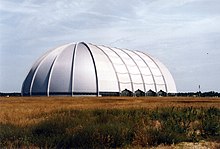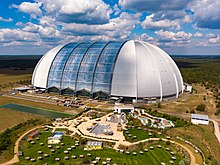Brand Airfield
| Airfield Brand "Аэродром Бранд" (closed in 1992) |
||
|---|---|---|
|
|
||
| Characteristics | ||
| ICAO code | EDUC | |
| Coordinates | ||
| Height above MSL | 74 m (243 ft ) | |
| Transport links | ||
| Distance from the city center | 69 km south of Berlin (Dom) | |
| Street | L 711 | |
| train | Fernbahn Berlin-Görlitzer Railway Company / Deutsche Reichsbahn / Deutsche Bahn | |
| Basic data | ||
| opening | 1938/1939 | |
| operator |
|
|
| surface | 620 ha | |
| Terminals | 1 | |
| Employees | 4800 soldiers by 1991 | |
| Runways | ||
| North (09R / 27L) | 2500 m × 50 m concrete | |
| South (09L / 27R) | 2500 m × 50 m concrete | |
| Southeast (16/32) | 2000 m × 50 m concrete | |
The former Brand Airfield is located about 60 kilometers south of the center and about 35 kilometers south of the city limits of Berlin near Briesen / Brand , a southern district of the municipality of Halbe . He emerged from a 1938 set up air base for the Air Force of the Armed Forces . After the withdrawal of Soviet forces in 1990 and the handover of the site to the German authorities, the company purchased CargoLifter the area in 1998. In the year 2000, cargo lifter on the site of the largest unsupported hangar of the world to this load airships to construct . After the insolvency of CargoLifter in 2002, the airship hangar was sold to an investor from Malaysia who has been running a tropical amusement park called Tropical Islands in the hangar since 2004 .
Directions
The airfield used by the Group of the Soviet Armed Forces in Germany (GSSD) until 1990 can be reached from the federal highway 13 (junction Staakow ) on the state road 711, which leads from the highway past Brand in a northeast direction to Krausnick .
With the train the system via which the station fire at the Berlin-Görlitz railway reached.
history
1938–1945: Air base of the Wehrmacht Air Force
As Briesen Air Base, Brand Airfield was an air base of the Air Force. In 1938/39 barracks were built for the aviators and sidings from the Brand train station for supply purposes. As early as 1939, Brand received a 1000 m long grass runway . The Horst, which was expanded into an airfield, was classified as a landing site. There were no active airborne units stationed here. From 1939 to 1942 it was the training airfield of the Aviator Training Regiment 82, the later FFS A / B 82 (Pretzsch pilot school) and until September 1944 the pilot school A / B 3 Guben. A school building was specially built for the pilot schools.
1950–1992: Front bomber base of the Soviet Air Force
- Further use and expansion by the air forces of the Soviet armed forces
The Soviet armed forces , which remained as a crew in Germany after the end of the Second World War , expanded the small airfield in 1950/1951 with a 2,500 m long concrete northern main runway. In 1958 another 2,000 m runway was added as an escort runway. The Soviet planners used an airfield scheme common in the Eastern Bloc in which the decentralization areas were remotely located. A typical feature of this scheme is: A 2000 m long taxiway, here the runway 16/32, leads away from the main runway 09L / 27R and leaves the central airfield. At the end there is a parking facility with shelters as well as storage and ammunition bunkers. In the fire, only small paved storage areas were created, the size of which was intended for MiG-17 escort fighters . In later years a command post and a special weapons store were created in the area of the parking facility , in which nuclear bombs were stored for the aircraft types stationed at the airfield.
This scheme was used in the following Warsaw Pact countries and other socialist states:
- VR Albania : Gjadër , Kuçova
- GDR : Brand Airfield; Templin / Groß Dölln airport ; Welzow airfield
- Estonian SSR : Ämari
- SR Slovenia : Cerklje
- ČSSR : Bechyně ; Líně
- VR Hungary : Kecskemét ; Taszar
- Expansion of the airport infrastructure
- 1958: Establishment of a decentralization zone on the southeastern 2,000 m long reserve runway
- 1969/70: Construction of 10 aircraft covers , (type AU-16/1, arched cover made of precast reinforced concrete, usable area: 448 m², dimensions [m]: 28 × 16 × 16, function: splinter protection cover for reconnaissance aircraft / front bomber Jak-28)
- 1974: Construction of a flight control center
- 1975/76: Construction of 18 aircraft covers (type AU-13, arched cover made of precast reinforced concrete,
usable area: 361 m², dimensions [m]: 28 × 12.6 × 6.9,
function: splinter protection cover for fighter-bombers Su-7 / Su-17) - 1978: Construction of another 6 aircraft covers (type AU-13)
- 1983: Construction of a covered maintenance hall (type AU-16, arched roofing made of precast reinforced concrete, usable area: 448 m², dimensions [m]: 28 × 16 × 16)
- 1990: The callsign was "ЗВЕРОБОЙ" (ZWEROBOJ)
- 1992: Handover to the Federal
Property Management Subsequently, new residential buildings, shops, vehicle shelters, ammunition bunkers and fuel stores were built.
- Unit overview
| From | To | unit | equipment |
|---|---|---|---|
| April 1945 | May 1945 | 71st Gw SchAP (Guard Battle Air Regiment) | Il-2 |
| 1951 | 1953 | 24th BAP (Bombing Regiment) | Il-28 |
| 1953 | 1954 | 296 IAP (Fighter Regiment) | MiG-15 |
| 1954 | 1956 | 80th BAK (Bombing Corps) | Rod |
| 1954 | 1967 | 277. BAP | Il-28 |
| from 1954 | unknown target representation device | Tu-6 (?) And Il-28 | |
| 1967 | 1968 | 668. BAP | Jak-28 |
| 1968 | 1989 | 116th IBAP (Jagdbombenfliegerregiment) later renamed 116th BAP |
MiG-17 , Su-7 later Su-24 |
| 1989 | 1992 | 911th APIB (Fighter-Bomber Air Regiment) | MiG-27 |
1998–2002: airship era
- September 1, 1996: Cargolifter AG is founded in Wiesbaden
- 1998: Acquisition by CargoLifter AG and dismantling of the northern runway
- March 1999: Start of construction of the shipyard hall as the largest self-supporting hall in the world
- November 30, 2000: Inauguration of the shipyard hall
- February 7, 2002: CargoLifter AG insolvency
2003 – today: Tropical theme park
- June 11, 2003: Sale of the hall and part of the surrounding area (500 ha) to the Malaysian company Tanjong.
- December 19, 2004: The Tropical Islands amusement park opens .
- 29.-31. August 2008: Use of the western part of the remaining runway as a target landing field as part of the annual flight rally around Berlin 2008.
- July 15, 2010: Founding of Tropical-Wings [GmbH], with the aim of reactivating Brand Airfield as a special landing site in cooperation with Tropical Islands .
- In December 2018 it was announced that the Tanjong Group would sell Tropical Islands to the Spanish company Parques Reunidos . The sale was completed in February 2019.
gallery
literature
- Lutz Freundt (Eds.), Stefan Büttner: Red Places , AeroLit Verlag, Berlin 2007.
- Jürgen Zapf: Luftwaffe airfields 1934–1945 - and what was left of them ; Berlin & Brandenburg, VDM Heinz Nickel , Zweibrücken, 2001.
- Lutz Freundt: Soviet Air Force in Germany 1945–1994, Volume 2 , Freundt self-published, Diepholz 1999.
- Lutz Freundt: Soviet Air Force in Germany 1945–1994, Volume 3 , Edition Freundt Eigenverlag, Diepholz 1999.
- Lutz Freundt: Soviet Air Force in Germany 1945–1994, Volume 4 , Edition Freundt Eigenverlag, Diepholz 2000.
- Henrik Schulze: History of the Jüterbog Garrison 1890-1994 - Jammerbock , Biblio-Verlag, 2000.
Web links
- Brandt airfield site plan
- History and pictures of the Brand Airfield
- History of the 911th Fighter Bombing Regiment, which was stationed on fire from 1989 to 1992 (Russian); PDF
Individual evidence
- ↑ airfield EDUC Briesen-Brand on Falling Rain
- ^ Soviet troops in Germany 1945 to 1994, memorial album, Moscow edition, «Junge Garde» publishing house, 1994; ISBN 5-235-02221-1 , page 21.
- ↑ Henry L. deZeng IV: Air Force Airfields 1935-45 Germany, (1937 Borders) , p 94 , accessed on September 9, 2014.
- ↑ Report ( Memento of the original from February 5, 2012 in the Internet Archive ) Info: The archive link was inserted automatically and has not yet been checked. Please check the original and archive link according to the instructions and then remove this notice. of the US Military Liaison Mission (USMLM) from 1982 about the FENCER fighter aircraft observed in fire
- ^ Büttner, Rote Platz, pp. 144/145
- ↑ Florian Bolk, Cornelia Dörries: CargoLifter Brand (The new architecture guide No. 25). Stadtwandel Verlag, Berlin 2001, ISBN 9783933743466 , p. 22.
- ↑ Dipl.-Ing. Rüdiger Bartel, Dipl.-Ing. Bernd Scheiber: Assessment of aircraft noise pollution at the Tropical Islands special airfield. (No longer available online.) AVIA Consult Bartel & Scheiber GbR, August 26, 2013, archived from the original on August 19, 2016 ; Retrieved August 19, 2016 .
- ↑ Tropical Islands in Brandenburg: Amusement park south of Berlin is sold to investor from Spain In: berliner-zeitung.de , December 12, 2018, accessed on December 12, 2018.





